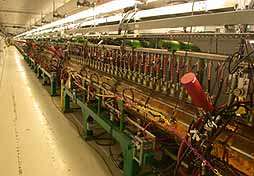ORNL's Spallation Neutron Source warms up for 2006

With the recent "warm commissioning" of its linear accelerator, Oak Ridge National Laboratory's Spallation Neutron Source (SNS) has passed a crucial test and milestone on its way to completion in 2006.
The SNS's linear accelerator, or linac, is composed of two sections: the "warm," or room temperature section, and a superconducting section that operates at temperatures hundreds of degrees below zero. Los Alamos National Laboratory, part of the team of six DOE national laboratories collaborating on the SNS construction project, is responsible for the warm linac.
Image: The warm section will provide 20 percent of the total acceleration of the Spallation Neutron Source's linear accelerator.
"The successful commissioning of the warm linac is another step toward the 2006 completion of the SNS, and again demonstrates the success of the collaboration of national labs in keeping the project on time, on budget and on scope," said SNS Director Thom Mason.
The warm section will provide 20 percent of the total acceleration of the 1,000-foot-long linac. The linac's superconducting section, provided by the Thomas Jefferson National Accelerator Facility, will provide 80 percent of linac acceleration. Testing also has begun of components of the superconducting portion, which consists of niobium cavities chilled by liquid helium to minus 456 degrees Fahrenheit.
Members of the Los Alamos SNS Division celebrated a job well done when components of the warm linac were shipped from the New Mexico laboratory to the project site in East Tennessee in April.
"Professionally, this was the job of a lifetime: being able to contribute to DOE Office of Science's biggest project," said Los Alamos SNS Division Leader Don Rej. "The excitement of working on big projects like this one comes from solving a seemingly endless string of insoluble problems, and solving them within budget and schedule constraints."
Because of their lack of charge, neutrons have a superior ability to penetrate materials. Researchers can determine a material's molecular structure by analyzing the way the neutrons bounce, or scatter, after striking atoms within the structure. Using computational methods and state of the art instruments, researchers will better understand the molecular reasons behind the materials' properties, which even with existing resources has resulted in the development of superior materials.
The SNS will produce neutrons for materials, biological and other scientific research by sending a high-energy beam of protons down a 1,000-foot linear accelerator to ultimately strike a mercury target, which will "spall" neutrons that are directed to the host of analytical instruments.
"The warm linac commissioning is significant because it verifies the performance of the entire warm linac and ensures successful operation of the entire facility," said SNS Accelerator Systems Division Director Norbert Holtkamp. "Testing of the cold linac components is time critical to allow for the transition of the tests from Jefferson Lab to ORNL, which is a major step toward the transition from construction to operation."
The SNS will increase the number of neutrons available to researchers nearly tenfold, providing clearer images of molecular structures. Combined with ORNL's High Flux Isotope Reactor, the SNS will represent the world's foremost facility for neutron scattering analysis, a technique pioneered at ORNL shortly after World War II.
In addition to Los Alamos and Jefferson Lab, four other national laboratories collaborate on the DOE Office of Science project: Oak Ridge, Argonne, Lawrence Berkeley and Brookhaven. Berkeley Lab has completed the "front end," where the proton beam is initially generated. Brookhaven has responsibility for the SNS's accumulator ring, a stage between the linac and target. Argonne leads the design of the facility's scientific instruments. ORNL is responsible for the target and will be responsible for operating the SNS.
When completed in 2006, SNS will become the world's leading research facility for study of the structure and dynamics of materials using neutrons. It will operate as a user facility that will enable researchers from the United States and abroad to study the science of materials that forms the basis for new technologies in energy, telecommunications, manufacturing, transportation, information technology, biotechnology and health.
Oak Ridge National Laboratory is a multiprogram laboratory managed for the Department of Energy by UT-Battelle.
Source: DOE/Oak Ridge National Laboratory















